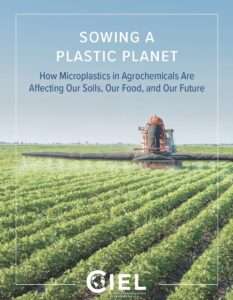
We are increasingly living on a plastic planet. Due to the explosion in plastic production and use, plastic pollution has grown exponentially in recent years. Tiny particles of plastic — or microplastic — are accumulating across the planet in even the most remote areas, in the air, in water, in soil, in plants, and in animals, including in our bodies. Humans are ingesting and breathing plastics and the toxins they contain through this continued environmental exposure.
One of the least known and most concerning sources of microplastic pollution is their deliberate addition to synthetic fertilizers and pesticides used in industrial agriculture. The application of plastic-coated agrochemicals to soils and crops directly introduces microplastic into the environment and potentially into the food supply. It also compounds the health and environmental hazards posed by agrochemicals themselves.
Synthetic fertilizers and pesticides, derived primarily from oil- and gas-based feedstocks, are already some of the most toxic substances in use today. Encapsulating them in microplastic, itself fossil fuel in another form, only heightens the risks. Because of its deliberate and controlled nature, microplastic pollution from plastic-coated agrochemicals is especially egregious, but it is also readily preventable. The only barriers are public awareness of the problem and political will to tackle it at its source by regulating the plastics industry.
Sowing a Plastic Planet: How Microplastics in Agrochemicals Are Affecting Our Soils, Our Food, and Our Future exposes the growing use of microplastics in agrochemical products, the industry’s promotion of this practice, and its threats to human health and the environment. It concludes that, in the face of known risks and the significant probability that plastic-coated fertilizers and pesticides only add to existing harm from toxic chemicals and microplastic, their production and use should be banned.
Read the key findings of the briefing here
—
Table of Contents
Executive Summary and Key Findings
Introduction
Microplastics: Tiny Plastic Particles That Persist in the Environment — and in Our Bodies
Primary Microplastics Pollute by Design
Microplastics Accumulate in Ecosystems and Food Chains
The Agrochemical Industry: A Large and Growing User of Intentionally Added Microplastics
Available Data Indicate That Agriculture Is One of the Largest Users of Intentionally Added Microplastics
Market Trends Show the Use of Agrochemicals with Intentionally Added Microplastics Is on the Rise
Plastic-Coated Agrochemicals Directly Release Microplastics into the Environment
Old Technology, New Packaging: How Industry Sells Microplastics in Agrochemicals
BOX: Producer Profiles: Agribusiness Giants and Specialty Firms Focus on Coated Fertilizers and Pesticides
Compounding Risk: Agrochemicals Plus Microplastics Equals a Toxic Combination
The Intrinsic Risks of Synthetic Pesticides and Fertilizers
Microplastics Are a Carrier for Toxic Chemicals
Physical Hazards of Tiny, Mobile Plastic Particles
Toxicity of Additives and Chemicals Used to Produce Plastics
External Toxins Absorbed in Plastics
Dangerous Interaction: Chemicals and Coatings
Microplastics Disturb Soil Ecosystems
The Need for a Precautionary Approach
Preventable Pollution: Curbing the Use of Intentionally Added Microplastics
Conclusion and Recommendations: Tackling the Toxic Triad
